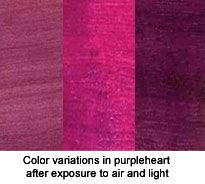|
|
Ask the Staff
Question:
I make
small boxes and enjoy using colorful exotic woods such as purpleheart.
I just hate the way it turns brown over time. What is the best finish
for this type of wood if I want it to retain its rich purple hue?
Answer:
Purpleheart,
also known as amaranth or violet wood, is renowned for its chameleon-like
quality. The heartwood is initially a muddy gray-brown, but when
it is cut and exposed to the air, it changes to a strikingly bright,
vibrant purple. Prolonged exposure to air and light then darkens
the wood to a dark-purplish brown or dark brown, but the purple
color can be restored by sanding or re-cutting the wood.



Short of an opaque pigmented coating that completely obscures the
wood and blocks UV light,
no finish can completely keep purpleheart,
padauk, redheart and other brightly-colored woods from darkening
over time
. However, a clear finish that contains UV absorbers
can at least
slow
the process by providing some protection
from air and light. UV absorbers are chemicals added to clear finishes
that work like sunscreen and absorb UV radiation, dissipating it
as heat. However, as with sunscreen, the UV absorbers wear
out over time, so the protection is only temporary.
The most effective UV-resistant coatings are marine-type finishes,
such as
McCloskey Spar Marine Varnish
and
Waterlox Original Marine
Finish
. Marine finishes tend to have more UV absorbers and can better
withstand direct sun than traditional spar varnishes. Lower-end
home center finishes marketed for their UV resistance very often
don't contain sufficient UV absorbers to be effective. Many oil
finishes, regardless of the amount of UV absorbers they may contain,
are applied too thinly to provide any real protection. These finishes
don't build on the wood, so there isn't adequate thickness for the
UV absorbers to be of much use, nor do these thinly-applied finishes
effectively keep air away from the wood. For best results, a thick
film must be built on the wood.
For
continued
UV resistance, finishes must also be properly
maintained. This entails sanding off the top coat every year or
so or when the finish dulls, and re-applying a couple of coats.
Projects or pieces that remain indoors with minimal exposure to
sunlight will not require such frequent maintenance.
|
|






